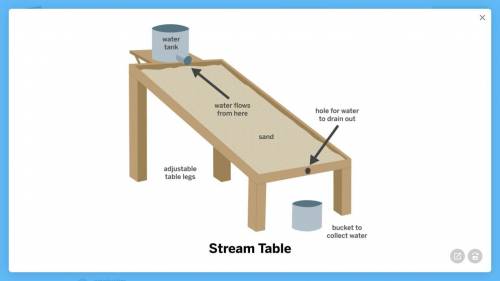
Chemistry, 20.11.2020 01:00, alligatorsocks
Using Models to Answer Questions About Systems
Armando’s class was looking at images of rivers formed by flowing water. Most of the rivers were wide and shallow, but one river was narrow and deep.
Armando’s class thinks that this river is narrow and deep because:
the hill that the water flowed down was very steep, or
the sand grains that the water flowed through were very small.
Armando designed the model below to try to answer the question: Why is this river so narrow and deep?
1a. What features of this model will help Armando answer the question?
1b. How could Armando use this model to test the idea that very steep hills lead to narrow, deep rivers?
1c. How could Armando use this model to test the idea that very small sand grains lead to narrow, deep rivers?
2. Armando thinks that it is the very steep hill that makes this river narrow and deep, but his classmate thinks it is the small size of the sand grains that the water flows through. What results from the model would be evidence that Armando’s idea is correct?


Answers: 1
Other questions on the subject: Chemistry

Chemistry, 21.06.2019 19:00, lizbeth232001
Which of the following best explains why the end of a spoon sticking out of a cup of hot water also gets hot? question 7 options: the heat from the hot water is conducted through the spoon handle the hot water heats the air surrounding the upper part of the spoon. the hot water causes a physical change in the spoon handle. the hot water causes a chemical reaction to take place in the spoon.
Answers: 2

Chemistry, 22.06.2019 13:30, Sbeech7246
Why does asexual reproduction result in offspring with identicle genetic variation
Answers: 2

Chemistry, 22.06.2019 17:40, adantrujillo1234
Areaction in which products can react to re-form reactants is
Answers: 1
Do you know the correct answer?
Using Models to Answer Questions About Systems
Armando’s class was looking at images of rivers form...
Questions in other subjects:



History, 12.05.2021 15:30

Mathematics, 12.05.2021 15:30




Mathematics, 12.05.2021 15:30

Physics, 12.05.2021 15:30






